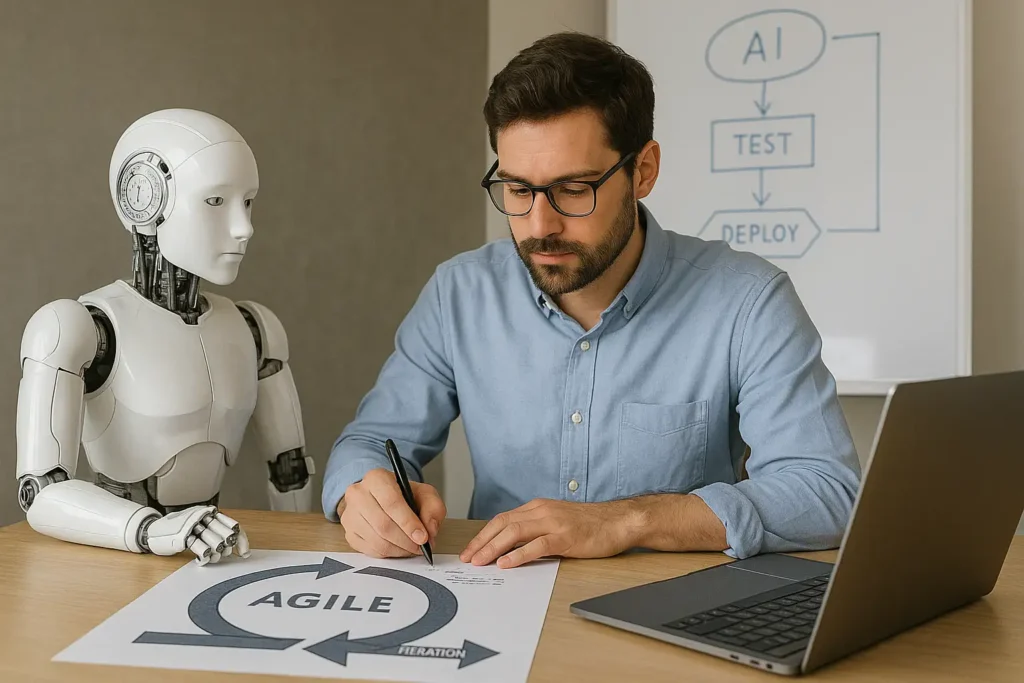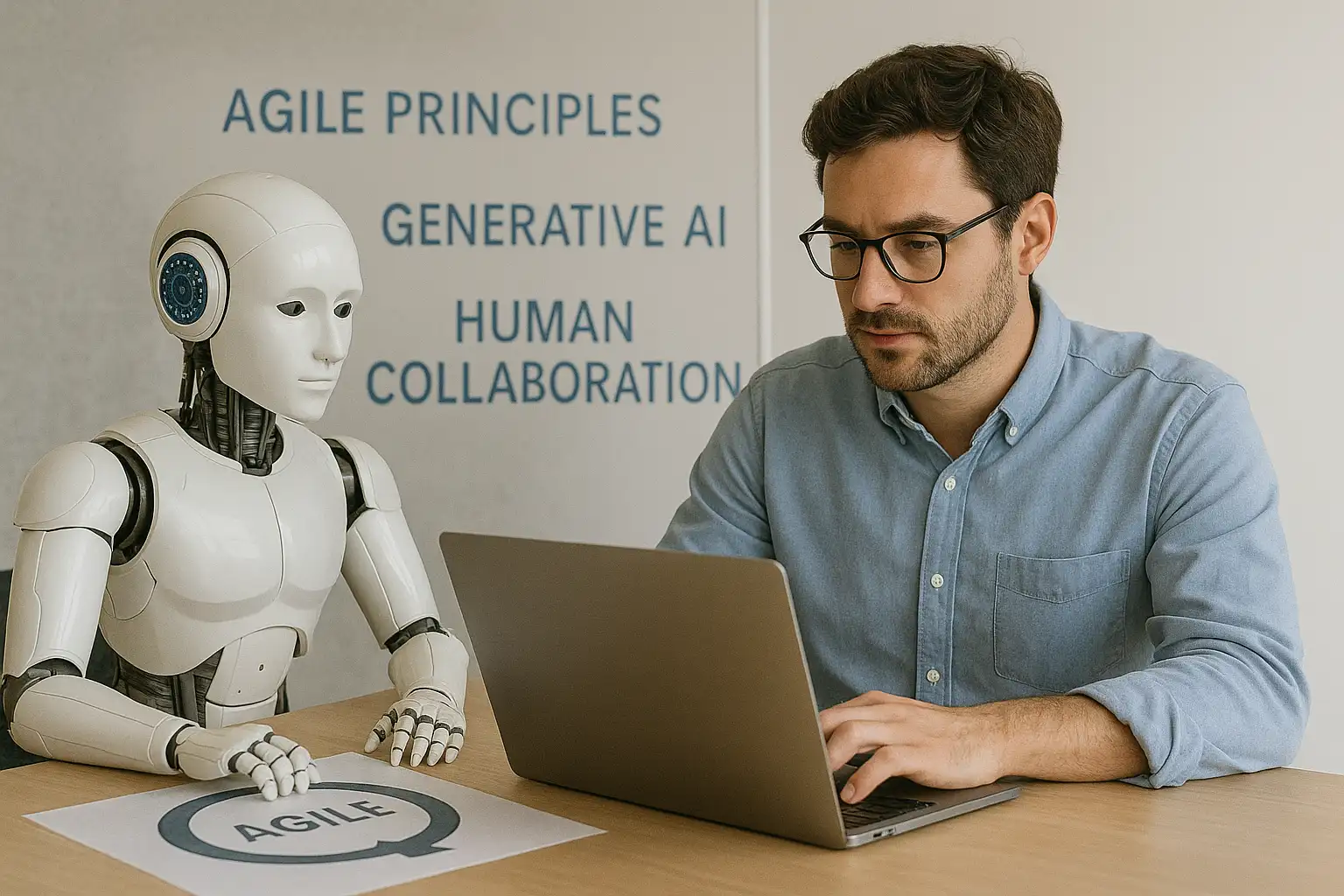AI and Agile: Shaping Practices and Mindset in the AI Era
Author: Hajime Estanislao, PMP®; Editor: Geram Lompon; Reviewed by: Alvin Villanueva, PMP®, PMI-ACP®
Projects in software development thrive on adaptability. Agile emerged as a flexible approach to managing shifting market conditions, emphasizing customer satisfaction, working software, and continuous improvement. With the rise of artificial intelligence (AI), including machine learning algorithms, predictive analytics, and generative AI tools, Agile faces yet another set of opportunities and challenges.
AI promises to streamline time-consuming tasks, improve team performance, and strengthen data-driven decisions. At the same time, Agile practitioners must guard against over-reliance, ethical concerns, and misalignment with Agile principles.
By blending AI tools with the Agile mindset of collaboration and flexibility, teams can deliver greater project outcomes while maintaining human oversight.
Why Agile, AI, and Project Management Intertwine
Agile, AI, and
- Agile practices provide a flexible approach that allows teams to adapt to uncertainty through short iterations, feedback loops, and collaborative decision-making.
- AI tools emphasize analysis of vast amounts of historical data, identifying patterns, and supporting informed decisions in real-time.
- Project management provides the structure, including governance, risk oversight, and stakeholder engagement, that ensures Agile practices and AI align with the business strategy.
At ROSEMET, we believe these three elements naturally intertwine because:
- Shared Focus on Adaptability: Agile’s incremental approach mirrors AI’s iterative development cycles, where algorithms are trained, tested, and refined. Both thrive in environments where learning and adapting are constant.
- Data as a Foundation: AI depends on clean, reliable data. Agile project management emphasizes transparency and visibility, ensuring data about velocity, risks, and outcomes is captured.
- Empowering Teams: Agile allows teams to self-organize. AI extends this by acting as a junior teammate to automate repetitive work and enable humans to focus on higher-value activities such as strategy and innovation.
- Driving Continuous Improvement: Agile retrospectives and AI-powered analytics complement one another. Teams can leverage AI to spot hidden patterns and then apply Agile practices to experiment with improvements.
- Balancing Human and Machine Strengths: Project managers ensure AI doesn’t overstep its role. ROSEMET stresses that human judgment, empathy, and creativity remain the foundation, while AI provides a supportive layer of insights and automation.
ROSEMET Best Practice: Treat AI as another teammate. It handles administrative tasks and identifies trends, but project managers and Scrum Masters retain accountability for decisions, coaching, and stakeholder relationships.
What Do We Mean by AI in Agile?
AI in Agile is about integration, not replacement. Intelligent systems enhance Agile practices while project managers preserve human-centered values.
- Generative AI drafts code, creates test cases, and summarizes customer feedback.
- Machine learning identifies risks, predicts project delays, and informs sprint capacity planning.
- AI-powered dashboards give visibility into progress, project requirements, and KPIs.
- Natural language processing (NLP) improves team communication, translates documents, and generates meeting notes.
Example:
During sprint planning, new tools and an AI assistant forecast workloads using historical data; the Scrum Master can then focus on creating a psychologically safe environment, where guidance on team discussions is paramount.
Core Concepts: Agile Principles, Generative AI, and Human Collaboration
Agile thrives on core principles: adaptability, transparency, and valuing people over processes.
- Agile principle: Use AI as a teammate that is capable of requiring oversight.
- Generative AI: Automates coding and documentation, freeing capacity for strategic activities.
- Human collaboration: Agile depends on trust, critical thinking, and domain expertise. AI may enhance decision-making, but cannot replace empathy or creativity.
ROSEMET Thought:
Never let AI diminish the psychological safety of Agile teams. Encourage open debate to discuss AI’s outputs and not simply accept them at face value.
Pros of AI in Agile Practices
- Productivity in Time-Consuming Tasks: Automates backlog grooming, sprint metrics, and reports.
- Smarter Decisions: AI leverages predictive analytics to highlight risks and forecast scope issues.
- Improved Code and Testing: AI-generated code reduces repetitive work while machine learning algorithms improve testing efficiency.
- Enhanced Communication: NLP tools support global teams, automate translations, and provide feedback summaries.
- Continuous Improvement: AI-powered retrospectives identify recurring blockers, reinforcing Agile’s principle of learning.
Cons of AI in Agile Practices
- Over-Reliance on Generated Code: Risks technical debt if unchecked.
- Data Quality and Ethics: Poor data collection can skew the insights.
- Risk to Human Collaboration: Overuse may reduce human collaboration and weaken trust.
- Skill Gaps and Resistance: Many organizations struggle to train Agile practitioners in AI adoption.
- Misalignment with Flexibility: AI’s prescriptive nature may clash with Agile’s flexible approach.
ROSEMET Best Practice: Balance automation with strategic activities. Use AI to suggest, not dictate, Agile decisions.
AI and the Agile Mindset
The Agile mindset emphasizes adaptability, empowerment, and delivering maximum value. In the AI era:
- Teams should view AI as a teammate, capable of handling repetitive work.
- Leaders should find a balance between making data-driven decisions, demonstrating empathy, and fostering creativity.
- Concentrate on more valuable activities such as coaching, strategy development, and engaging with stakeholders.
ROSEMET Thought:
Agile practitioners should use AI to identify areas for experimentation, but never let it override human curiosity or creativity.
Step-by-Step: Smarter with AI Projects
- Refine Backlogs with AI – Use analytics to prioritize user stories. Analytics should bake itself into the development process.
- Support Sprint Planning – Forecast capacity using data science techniques.
- Monitor Team Performance – Identify trends using dashboards, assisting in the performance monitoring and the implementation of agile methodologies.
- Improve Retrospectives – Analyze patterns from historical data, even from just a few examples.
- Strengthen Communication – Automate stakeholder updates and meeting notes.
Best Practices for Integrating AI into Agile (ROSEMET Guidelines)
- Start Small: Begin with low-risk tasks such as reporting and backlog analysis.
- Prioritize Data Quality: Collaborate with data scientists and data engineers to prepare and create models from reliable data.
- Train for Balance: Equip teams to combine critical thinking with AI outputs.
- Promote Psychological Safety: Encourage teams to challenge AI suggestions.
- Measure Outcomes, Not Just Output: Use AI to improve value delivery and project outcomes, not just speed.
Considerations: Human Judgment Matters
AI offers efficiency; however, human collaboration drives Agile progress. Teams must use judgment, empathy, and creativity to interpret AI insights, including input from data scientists.
ROSEMET Best Practice:
Always ensure that the Scrum Master or project manager is informed. AI may draft solutions, but humans decide whether those solutions fit the team’s needs.
The Future of Agile in the AI Era
The Agile community is moving into a hybrid age:
- Generative AI efficiently produces documentation and user stories at scale. Machine learning algorithms will assist in planning large projects. AI-powered tools are becoming standard in Agile ceremonies.
Agile practitioners who are guided by agile and
Wrapping Up: A Practical Way Forward
Aile,
But as ROSEMET emphasizes, Agile’s core principles, such as collaboration, adaptability, and people-first values, must remain central. AI continues to evolve, yet the Agile mindset ensures technology supports strategy and human connection.
By thoughtfully integrating AI, project managers, Scrum Masters, and Agile practitioners sustain agility, enhance delivery, and cultivate continuous improvement. These are the hallmarks of successful projects in the AI era.
References
Agilemania. (2024, January 15). The impact of generative AI on software development<span data-color=”transparent”>. https://agilemania.com/generative-ai-impact-on-software-development
Cognilytica. (2024). Cognitive Project Management for AI (CPMAI) methodology version 7 . Cognilytica. https://www.cognilytica.com/cpmai
Forbes Technology Council. (2024, June 24). AI meets Agile: Transforming project management for the future. Forbes. https://www.forbes.com/councils/forbestechcouncil/2024/06/24/ai-meets-agile-transforming-project-management-for-the-future
Harvard Business Review. (2023, February 21). How AI will transform project management . Harvard Business Review. https://hbr.org/2023/02/how-ai-will-transform-project-management


